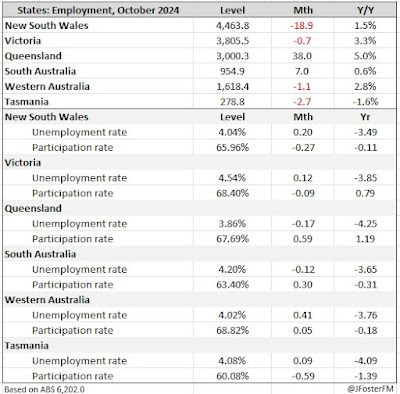Australia's unemployment rate remained at 4.1% in October despite employment posting its slowest rise in 8 months of 15.9k. Market reaction to today's report was minimal; simply put, labour market conditions remain robust and this is seeing pricing for an RBA rate cut coming no sooner than in the second half of 2025.
By the numbers | October
- Employment lifted by a net 15.9k in October (full time +9.7k/part time +6.2k), missing the consensus figure (25k) for the first time since March. September's employment outcome was revised to a 61.3k increase, down from 64.1k previously.
- The headline unemployment rate was unchanged at 4.1%, as expected; however, at 2 decimal places it lifted from 4.08% to 4.13%. The broader underemployment rate tightened from 6.3% to 6.2%, declining to its lowest since April 2023. Total labour force underutilisation was steady at 10.4%.
- Labour force participation eased from record highs to print at 67.1% from 67.2% previously. The employment to population ratio was down 0.1ppt to 64.4%
- Hours worked ticked up by 0.1% in the month, firming annual growth from 2.4% to 2.5% - its fastest pace in 13 months.
The details | October
Markets already appear to have quickly looked past today's report. Employment slowed to a 15.9k rise in October, its weakest outcome since March and below expectations for 25k; however, markets were unperturbed given they have seen Australia's monthly employment outcomes come in topside of consensus since the Autumn. Both full time (9.7k) and part time employment (6.2k) contributed positively to the headline figure. After October's outcome, the 3-month average increase in employment moderated to 41k from 52.2k.
Despite the notably slower rise in employment in October, the national unemployment rate held at 4.1% - in line with its 3-month average but above the cycle lows of 3.5% in late 2022/early 2023. An easing in the participation rate from 67.2% to 67.1% was key to the unemployment rate remaining unchanged. In my preview of today's report, I highlighted that over recent months, labour market conditions have started to tighten again. Further evidence of this was seen with the underemployment rate falling from 6.3% to 6.2% in October, an 18-month low. The overall underutilisation rate remained at 10.4%, down from the levels seen during the middle of the year.
The broader retightening of the labour market has occured alongside hours worked finding momentum. Hours worked lifted in October (0.1%), continuing a run of increases since the middle of the year, to be up 2.5% on 12 months ago.
In summary | October
Australia's labour market remains in robust shape; there is strong momentum behind employment - with forward-looking indicators, including unemployment expectations in this week's Westpac-MI consumer sentiment survey - pointing to this continuing; unemployment is low and participation is around record highs. These dynamics will likely reaffirm the RBA of its view that the labour market remains tight relative to full employment, a key underpinning of its hawkish narrative to near-term easing prospects to which the market has yielded to. However, there are signs that the inflationary pressures stemming from the labour market are easing following yesterday's report that showed growth in the Wage Price Index cooling to a 3.5% annual pace in Q3 (see here).







